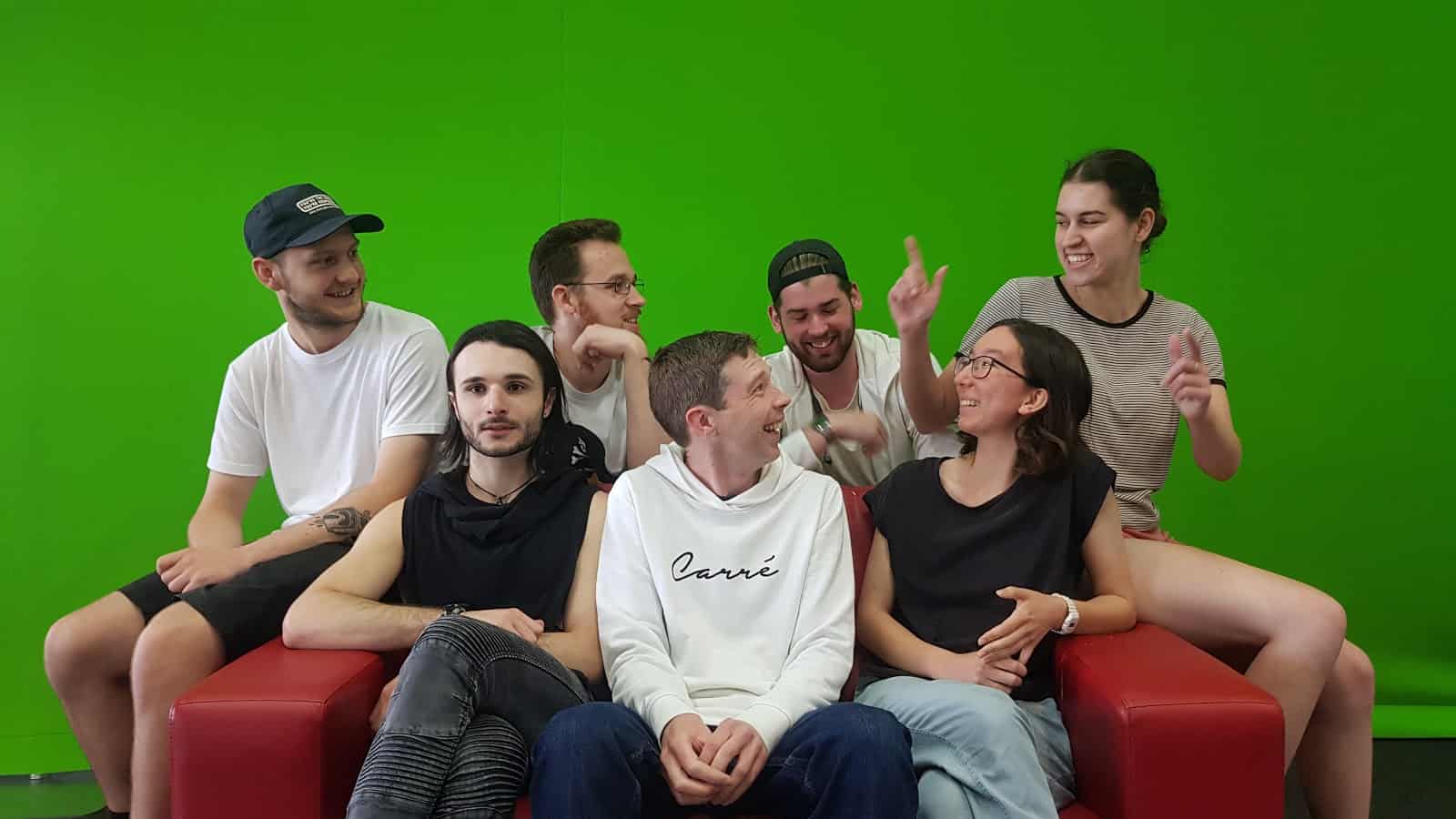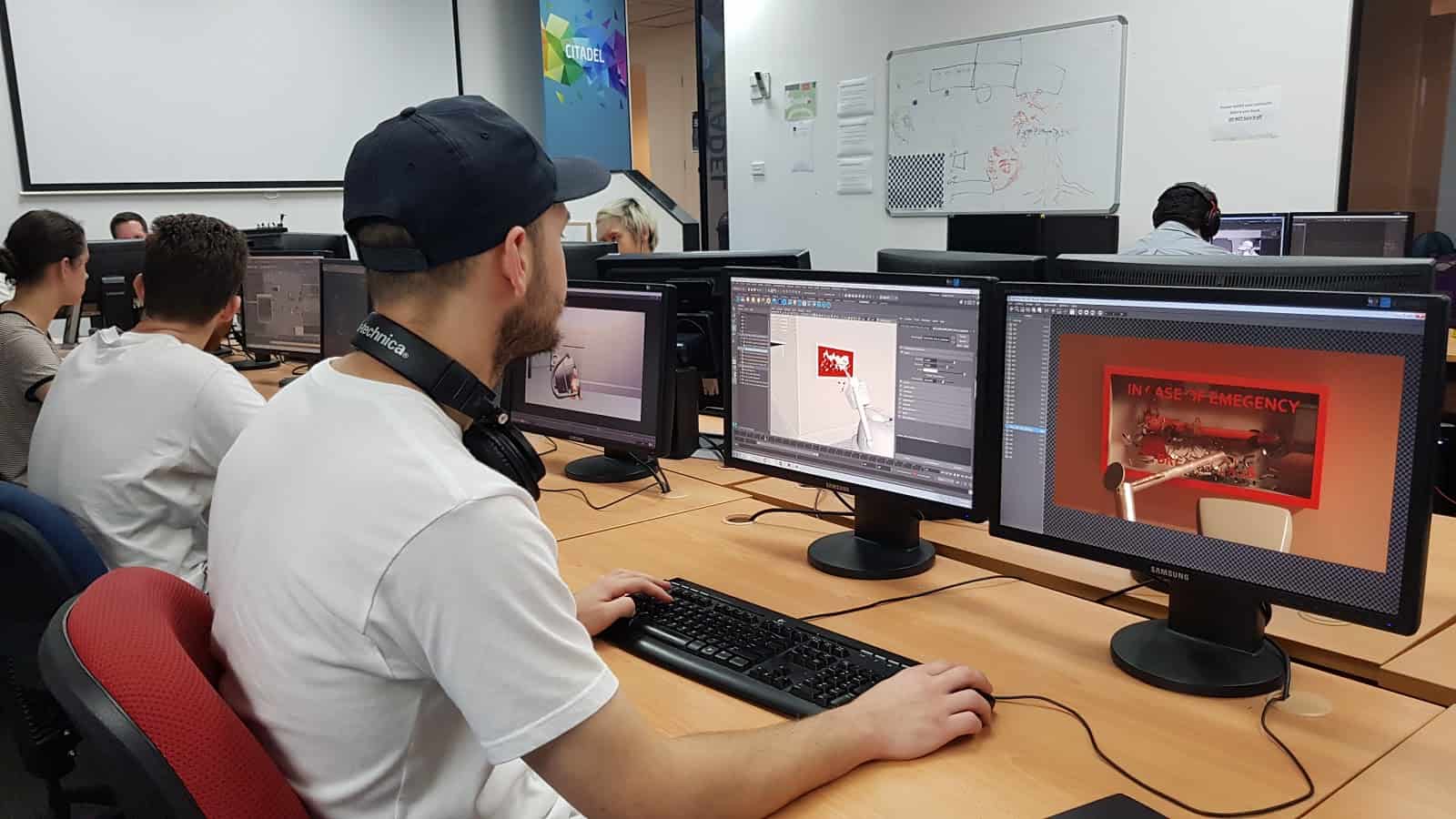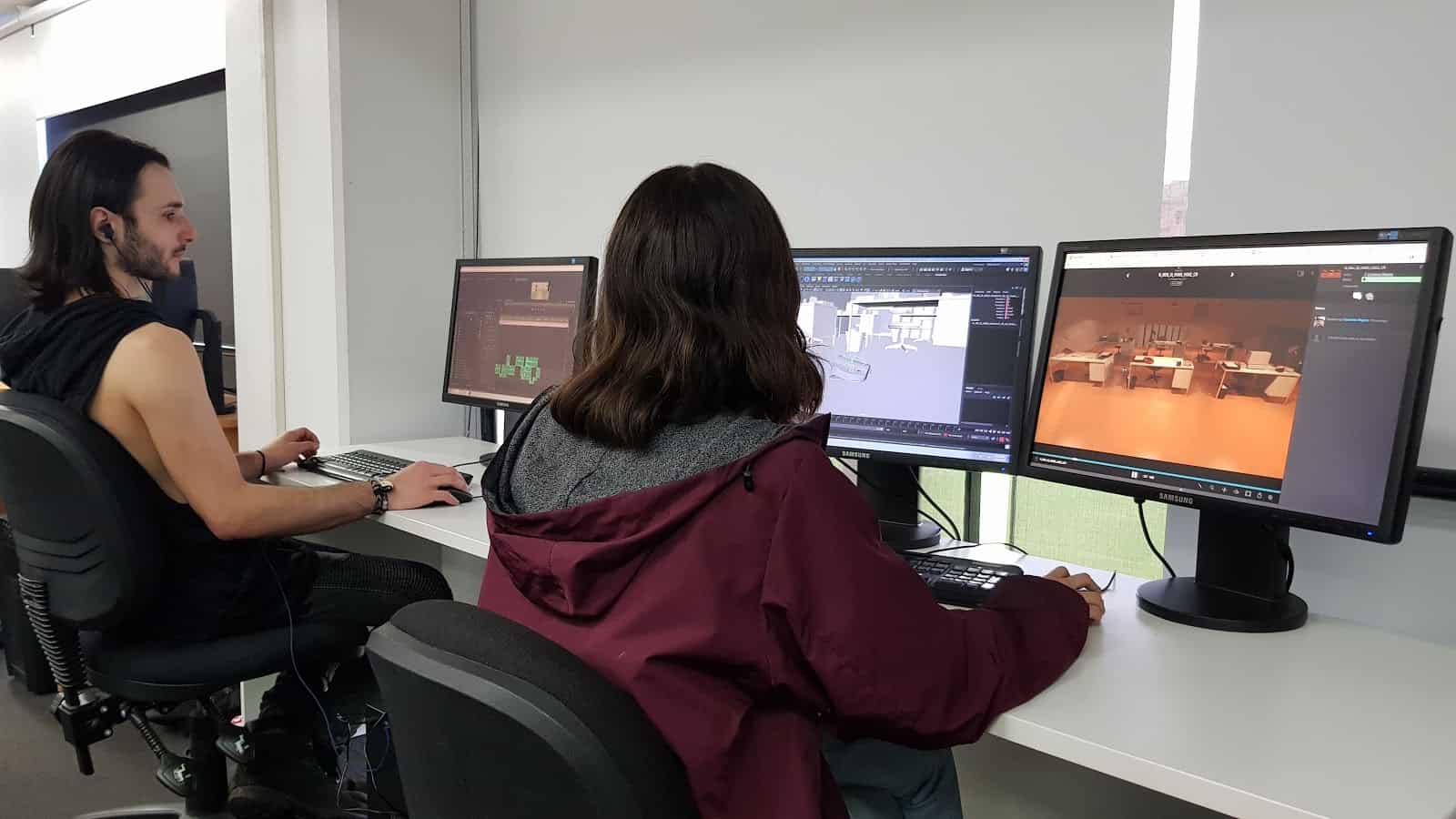How is a film born
We took to the classroom to chat with second year 3D Animation and VFX for Film team, ‘Cool Banana Studios’ to ask some questions about their short 3D film, “Suck it” and about their time at AIE.
What is the film about?
It is about a dated vacuuming robot, Zacuum, who is outshined by a more advanced model, Proto. Not only does the new model clean faster and move around with ease, it’s also able to polish the floor. In fear of losing his beloved job, Zacuum tries to keep up with the pace but he has limitations, like his power cord for example. He quickly becomes frustrated with the intruder and decides to take action.
How did you come up with the idea of your film?
During the story development unit in the course prior to pre-production. We had formed our team earlier so we had some extra time to flesh out our ideas. We had too many ideas to choose from but eventually found the one we all agreed on and had the most interest in. It still took us all of pre-production to really hone in on what the film would be through editing the script, storyboards and concepting our character.
What makes it different?
Most of us made a cute short film for our first year major project so we decided to go in the other direction and make it a bit dark. It’s definitely been entertaining seeing people’s different reactions to it.
What is the art style like?
We are imitating real life objects and textures (PBR) whilst still keeping the style grounded with more cartoony elements, akin to Pixar.
We are approaching the submission deadline, are you going to make it?
Yes, we think it is achievable to have the project completed on time with the way we are currently going and how we have approached our schedule. Learning from past projects, we have made sure to account for troubleshooting time because something always goes wrong.
Where do you hope to see this film once you are done?
We are focusing on producing a polished short film that we are all proud of and had fun with. When planning the project we made sure everyone had a role they were happy with and could produce work for their showreels. We’re planning to enter into contests and see where it goes.
As a team, what has been the hardest part of development so far?
Making big decisions has probably been one of the most difficult aspects of the development. Initially we had way too many ideas to choose from so it was a challenge to narrow it down to just one. Then getting the pre-production, including concepts, to a point we were happy with to start production was a big step. Then going all the way into detail can be difficult as well, like deciding what texture the walls should be. It’s just not something you think about until you come across it.
As a team, what has been the easiest part of development so far?
The easiest part of development so far has been changing parts of our film based on feedback. For example, one of our earlier concepts of Zacuum got shot down but we were able to take the criticism and redesign our character almost completely. The outcome was a design we were all really happy with, even more so than the previous. After this in particular, we made sure to take feedback on board with the aspects that were going to improve our project despite having to put more work into it. Taking on feedback can also be difficult at times with conflicting opinions so it has been super helpful having our teachers guide us.
- As a team of artists what is it like to work as a “______”?.
Alex Annetta - Modeller and Texture Artist
I’m primarily making models for this project. All the assets, including the characters, are hard surface, so I’ve been sticking with Maya to get the work done (no ZBrush required). For the more complex assets, I just start with forming simple shapes to block out the main components and progressively add details with edge loops.
In regards to working in a team of artists within the 3D pipeline, modelling has been relatively straightforward. Essential assets are prioritised, such as the characters and main props needed for interaction in animation, while 'display' models are worked on secondarily so that the other artists can get to work on the other completed models asap (i.e. for texturing and animation). Models that need to be rigged require some extra care and attention to detail to ensure the rigger can do their job efficiently and effectively, e.g. properly naming and organising geometry in the outliner, freezing transformations, and centering pivot points.
Ben Hart - Producer, Generalist
I was pulled into the group a few weeks after this final project started, as the film needed a producer. It was a struggle for the first few weeks getting organisation up to speed and aligning with the group. Now everything is in place and moving along nicely I've settled more into a generalist role for the group, covering any jobs that hadn't been considered and trying to keep the team moving forward together. So far I've spent most of my time creating environment and objects to flesh out our scene.
It's been a good challenge trying to stay within a specific time period for all our assets. It will be time to move onto more texture work and lighting pretty soon. We're at the stage where most of the film is starting to tie together and be assembled into shots. It’s been great watching it all move from ideas to a living thing. I think we still have a way to go but it's looking good. Everyone is working hard and this short film has been a great way to see how we might be working in the industry. We've been working together well and any problems that have come up are dealt with pretty quickly by our awesome efficiency. I'm looking forward to seeing just how far we can take the film toward what we hoped it would be.
Megan Leach - Concept and Storyboard Artist, Lead Animator
Being the team’s sole concept and storyboard artist in the project’s preliminary stages I worked closely with the rest of my team to ensure I was fulfilling their vision for the project. I especially worked closely with our director, Claire, as she has the final say in all art decisions, so we would collect reference together for characters or environment and then I’d illustrate iterations of concepts from which I’d get feedback from her and the rest of my team.
I worked with Claire again when storyboarding as any changes she made to the script I had to apply to the storyboard. This stage was fun although challenging at times, but it was really rewarding at the end of pre-production when we had characters, an environment and a storyboard that we were all happy with. In my main role, as an animator, I work a bit with all members of the team, but mainly Claire again as she’s our team’s rigger and second animator.
I tested and gave feedback on different iterations of the rig and let her know if there was anything she could add to make the animation process smoother. I work with our modellers, Ben, Zac and Alex, to coordinate the layout of the room in relation to the animation, as well as any issues with props. I also work with our VFX artist, Dylan, to figure out the best way for the animation to mesh with the effects. Overall I’m enjoying the project so far and have confidence in my team to reach an awesome end result for our film.
Zac Rae - Model, Texture and Lighting Artist
My role in the team as a Model and Texture artist is to create assets that follow the teams and director's’ vision. Sometimes this requires lots of research on how something is made or gathering plenty of quality reference images so that we can accurately recreate the asset. As a texture artist I need to make sure all materials are physically accurate and fit aesthetically with what we the team would like for the scene. This also plays into my role as a lighter. Lighting can have the most influence over how a scene and materials ultimately look.
Textures and Lighting have a very close relationship and there is a lot of back and forth to get it right.
Another role that I am helping the team with is scene assembly. Scene assembly is where all the assets, characters, animation and lighting come together to be assembled and set up for rendering the final shot. It is very important that the scenes are set up with the latest versions of all the assets, the scene is as clean as possible and optimized for rendering. I have to work closely with every member of the team to make sure all the work they have done is there best and up to date work.
Dylan Smith - FX Artist
As an FX Artist I mainly work with all the stuff that moves but isn't easily animated by hand. This is normally stuff like fire, smoke, water, cloth, dust, destruction, etc. On this project I've had to do a lot of work with cables, which is an area I haven't really had any experience with until. This project. It’s been a challenge but thankfully there are a few resources floating around that have helped me figure things out.
My role is placed towards the end of the production pipeline, which mean I rely on and work closely with the rest of the team in order to get shots done. I work particularly closely with the modellers, riggers and animators to make sure that my work looks nice and realistic, but also fits in with what they have made. FX are usually either born from or tied closely to existing assets in the scene and will usually need to interact with the things around it so keeping clear and constant communication with the other departments is very important.
Claire Worsman - Director, Character Rigger and Animator
As the director, it is my responsibility to make creative decisions. This means I have to work closely with everyone in the group to make sure they know what to create. Sometimes this means direct instructions, providing reference images, drawovers or just general feedback. Most of the time I set a basic design brief/expectation for models, animation, lighting etc. This team has been so great with their art, they come back with work that exceeds my expectations. It’s so interesting to see everyone’s creative input. Other times they can come back with issues with creating certain design aspects and work with me to find an alternative.
As character rigger, I had to work with Alex, Ben and Zac who were modelling the characters to make sure the character was able to move as intended. Megan’s input was crucial to add/remove controls or attributes to help character performance and make animation run smoother. It was then really rewarding to start animating with the rigs alongside Megan, the lead animator.
As a team have you had to do much research on how to make your specific film?
Yes we had to do a lot of research for this film. We took inspiration from similarly styled short films and stories to figure out what the core of our film needed to be. Moving on to pre-production we had to research and find reference for the models, lighting, camera movements etc. Everything that would help us with what our film would look like or how to make it. Our setting for example is time specific. We had to research a lot of objects and offices from the 60s-80s to figure out which direction to go for. We have all of these research collected and use it for production.
What measures have you taken to make sure you will get the project done on time?
We have tried to maximise our productivity in the early stages so we have time to troubleshoot and polish the project. Coming in on off days and extra work at home has been crucial. We probably wouldn’t be halfway through what we are now if we didn’t take the extra time to work on the project. Another big thing has been delegation. Sometimes a task has proven to be too big for one person to handle so we have to shift the tasks around to make sure it gets done. This heavily relies on strong, effective communication. If two people were working on the same character model we had to make sure they were working on different parts but adhering to the design brief.
Has AIE readied you for developing a film?
We believe AIE has prepared us for producing a film, especially in a small studio setting since we had to work in multiple disciplines. This project has furthered our understanding of the pipeline and given us the skills to work in a team of different disciplines.
What would you tell people who may be interested in studying at AIE?
AIE has a great community, everyone is willing to help anyone. Be prepared to work hard and work at home. There’s a great deal of dedication needed to get great results. Learn outside of the classroom as well. Teaching yourself and working on side projects is so valuable. It gives you the opportunity to improve workflow, problem solving skills and you have more material for your showreel.
How long do you have to finish it?
The project is due on the 12th of November.
Are you having fun?
Yes. It is challenging but we are making the most of the experience and creative process.



